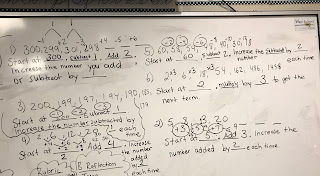Tremendous Tuesday!
We began the day with Math. We explored number patterns today. Ms. Jaskolka gave us 6 number patterns and we needed to find the pattern rule and the next three numbers for each pattern while working in groups.
We ensure that we begin our number pattern with the first number in our pattern. Then we need to determine if we are adding, subtracting or multiplying next.
45, 47, 49, 51 ….
Pattern Rule: Begin at 45. Add 2 each time. The next three numbers: 53, 55, 57
We also need to be aware that when working with number patterns, sometimes we need to think critically about the number pattern. For example:
52, 53, 55, 58, 62
Pattern Rule: Begin at 52. Add 1. Increase the number you added by 1 (since we are adding 1 to the number that we are adding by: 52+1=53 53+1+1=55 55+2+1=58 58+3+1=62)
Next, we worked on our summary for The City of Ember.
After first recess and lunch we performed 6 experiments to learn about air. Before conducting our experiments, we reviewed the scientific method:
The steps of PHEOCA are: Purpose, Hypothesis, Experiment, Observation, Conclusion, and Application
Fair Test:
We also reviewed our understanding of what makes a fair test:
You conduct a fair test by making sure that you change one factor at a time while keeping all other conditions the same.
In order for a test to be fair or scientifically sound, scientists are required to ensure only one thing (this is called a variable) is changed.
An experiment in which only one variable is changed at a time to allow a fair comparison.
An experiment is an example of a fair test when there is only one independent variable. In a fair test, only one element is changed by the scientist while the other elements remain the same.
Variables - are the things that can change during an experiment. Something that can vary during an experiment.
Controlled Variable - the things that you try to keep the same in an experiment or investigation.
In simple words, a controlled variable is something in a given experiment that can be fixed or would not be changed at all during the course of the experiment.
A controlled variable is the element or feature that cannot be changed during the course of an experiment. The controlled variable is kept constant so the changes in other variables can be observed more easily
Independent variable:An independent variable is one that is changed by the scientist in order to facilitate an action or reaction within the given experiment.
Dependent variable:
The dependent variable is the one that changes as a result of the independent variable. The dependent variable is what gets measured during an experiment and what is affected by the other elements in the experiment.
We did an example as a class to better understand these scientific terms.
First, we would come up with a problem: How much water does a plant need to grow?
Then we would make our hypothesis.
Next, we would perform our experiment. We determined that the controlled variables would be: the soil, seed, container, and amount of sun we gave each plant (these variables do not change).
The independent variable would be how much we water each plant.
The dependent variable would be how tall the plant grows. So how tall the plant grows is dependent how much it is watered.
Through our experimentation today we learned about the strength of air pressure, that air takes up space, and that air has mass (this was shocking to many of us!!!).
After second recess and lunch we had physical education with Mr. Orr.
Homework:
1. Read Daily
2. Finish summary
3. Math – Questions 1, 2 and 3
4. Math test Monday
5. Flight test Tuesday
6. Writing due Monday (if kids ruled the world)



















No comments:
Post a Comment